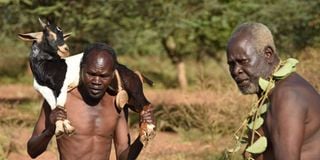Premium
Where curses are used to resolve land disputes

An elder carries a goat for slaughter during a ceremony to curse alleged grabbers of a 650-acre farm, being claimed by the Kongot clan in Elgeyo Marakwet County, on August 10, 2018.
Members of the Kalenjin community have maintained an informal system of settling land disputes which have, for many years, remained a thorny issue especially among sub-clans in Kerio Valley region.
They use landmark features such as white stones and rivers to demarcate boundaries, which signify areas belonging to each clan and no adjustment should be made since they were made during time immemorial.
Most land in Kerio Valley is communally owned and the landmark features, which stand to date, are recognised despite the introduction of a digitised survey system by the government.
Elders comprising representatives from different clans convene consultative forums whenever disputes emerge especially when landmarks are distorted.
Elders in the region usually conduct rituals to inflict pain and suffering on grabbers of their ancestral land and those who have interfered with original boundaries.
White stones erected centuries ago are still recognised in the region as landmarks and boundaries between different clans and communities.

Elders slaughter a goat during a ceremony to curse alleged grabbers of a 650-acre farm, being claimed by the Kongot clan in Elgeyo Marakwet County, on August 10, 2018.
The Nation was recently invited to such a cursing ceremony - attended only by men - which is conducted at dawn by half-dressed, grey-haired elders.
The elderly men from the Kong’ot community slaughtered an unblemished goat at dawn and spilt its blood on the ground while chanting traditional songs to cast a spell on the perpetrators. The elders then left the goat’s carcass untouched and hurriedly left the area.
Nature's intervention
The elders claimed that their 650 hectares at Chemurgui in Keiyo South sub-county had been grabbed, registered and sub-divided to 40 wealthy individuals who are now living and farming on it.
“We’ve lost confidence in government officials addressing our plight. We have made endless trips to land offices to seek audience but the influential individuals interfere,” said Kong'ot clan chairman Joel Kiptunoi.
“Let nature intervene on our behalf. We swear that land grabbers will enjoy no peace until they surrender the land to us.”
According to the clan members, their forefather, Kong'ot, had six sons whose descendants have multiplied to more than 10,000 people.
“It is sad that we cannot cater for our families because we have no land. We have been accommodated by relatives since our land has been occupied by well-connected individuals,” said John Bett, another elder.

An elder is picured during a ceremony to curse alleged grabbers of a 650-acre farm, being claimed by the Kongot clan in Elgeyo Marakwet County, on August 10, 2018.
The elders were angered after they discovered their communal land has been fraudulently registered by strangers and sold out to third parties in an intricate land racket.
The elders claim that some perpetrators have died in mysterious circumstances.
No registration
It also emerged that the majority of land in Kerio Valley is communally owned through clans and, therefore, lacks registration documents.
According to the aggrieved residents, their petitions to State agencies to revoke title deeds and revert the land to the community have failed.
Spilling of blood in the Kalenjin community signifies that doom and death will befall the grabbers and their families if they fail to surrender the land.
Kong'ot clan secretary Nicholas Kiplagat claimed that they are aware of a syndicate involving senior officials in the government who grab land in the vast Kerio Valley.
The Kapkomool, another clan in Kerio Valley, has launched complaints with the National Lands Commission (NLC) following a dispute with Kapmooi clan over ownership of ancestral land at Lower Sego and Chespsigot in Kerio Valley region.

A section of the 650-acre farm being claimed by the Kongot clan in Elgeyo Marakwet County, which has allegedly been grabbed, as pictured on August 10, 2018.
The NLC officials, top security team and members of the two warring clans adopted a task force report that recommended traditional mechanisms, including use of permanent natural features like rivers and foothills, to resolve the land disputes.
“Our role is to unite the two clans and application of traditional dispute resolution mechanisms has proved effective in determining such ancestral land ownership,” said Joseph Korir, NLC Elgeyo Marakwet County coordinator.
He regretted that most land in Kerio Valley is owned by the community members, which slows down the process of issuing land title deeds.
Fresh demarcation
The row erupted after members of the Kapkomol clan claimed that a part of their ancestral land in Chepsigot has been annexed by rival clans and influential personalities for private development.
“We welcome the recommendation of NLC to carry out a fresh demarcation process and allocate us our genuine acreage of ancestral land,” said Daniel Kotut, chairman of Kapkomool community.
They want more than 200 people who have invaded the land to facilitate fresh allotment.

A section of the 650-acre farm being claimed by the Kongot clan in Elgeyo Marakwet County, which has allegedly been grabbed, as pictured on August 10, 2018.
The Ministry of Lands in 2005 suspended sub-division of the disputed land following complaints by the Kapkomool clan.
The boundary row has been driven by the recent discovery of oil deposits and increased demand for land along the agriculturally rich Kerio Valley region.
“The boundary dispute can best be resolved by use of landmark features and original colonial maps that demarcate the area each clan occupied,” said Ernest Komen from Kapmooi clan.
Among areas disputed by the two clans include Chepsigot and Endo, which have plenty of pasture and water for livestock.






